Scroll to:
Psychophysiological training of pilots for cases of emergency cockpit decompression
https://doi.org/10.47183/mes.2025-271
Abstract
Introduction. In the stratosphere, when the aircraft cockpit is depressurized, the pilot switches to breathing pressurized oxygen. However, breathing under such conditions leads to the development of adverse processes that affect the functional state of the body and reduce the quality of aircraft piloting. Programs of psychophysiological training of pilots for such conditions include breathing and speech training under oxygen overpressure.
Objective. Effectiveness assessment of a five-day breathing and speech training course under oxygen overpressure in Vietnamese test subjects.
Materials and methods. The study involved 35 Vietnamese test subjects aged 19–32. The assessment of the development of breathing skills under oxygen overpressure (OOP) was based on the dynamics of psychological parameters and the pronunciation accuracy of control words. The study used a KM-35 demand oxygen mask in combination with a ZSh-7A pilot protective helmet and a VKK-15 altitude compensating suit to create counterpressure on the chest. OOP was created using the BARS-GD hardware and software complex. The developed course of breathing and speech training under OOP consists of five OOP breathing sessions, which are conducted once a day during five consecutive days. Each session involves breathing under OOP in a sequential and continuous manner at five stages with a breathing time of 2 min at each stage. OOP was created at levels ranging 150–1000 mmHg. The functioning of the central nervous system (CNS) was assessed based on the average time of simple and complex visual-motor reactions (SVMR, CVMR) and the response to a moving object (RMO). The level of situational anxiety, well-being, activity, and mood was assessed using the wellbeing, activity, mood (WAM) questionnaire. Statistical analysis was performed using the SPSS 26 software.
Results. As a result of the five-day training course, a statistically significant decrease in the pre-stress level of situational anxiety by 3.9% was observed. Prior to the training course, in the setting of simulated rapid cockpit decompression, a decrease in well-being and mood indicators by 3.7% and 5.7%, respectively, was noted. In addition, the experiment recorded an increase in psychophysiological reserves, which was confirmed by statistically significant changes in the time of simple and complex visual-motor reactions, as well as the results of testing the response to a moving object before and after the training course.
Conclusions. The data obtained confirmed the effectiveness of the developed five-day training course, as a result of which the test subjects increased their psychological and psychophysiological readiness to perform tasks under conditions of a sharp decrease in pressure in the pressurized cabin of an aircraft and the operation of high-altitude equipment. The developed five-day training regime of Vietnamese military personnel is recommended for integration into the training system of pilots for high-altitude and stratospheric flights.
Keywords
For citations:
Blaginin A.А., Vu Q.H., Annenkov O.A. Psychophysiological training of pilots for cases of emergency cockpit decompression. Extreme Medicine. 2025;27(3):367-374. https://doi.org/10.47183/mes.2025-271
INTRODUCTION
The current intensive development of aviation science and technology is associated with an increased emotional, physical, informational, and mental stress experienced by the pilot–aircraft–environment system. In this system, the pilot becomes an increasingly vulnerable element [1] due to the physiological and psychophysiological limits of the human being as a biological object [2].
Aviation medicine and flight physiology aim to preserve the professional health of pilots in the face of rapid technological advancements. This goal is achieved through technical solutions that compensate for the extreme factors of aviation flight and complex missions, as well as by continuously enhancing the professional reliability of pilots by improving their ability to perform tasks in extreme and emergency situations [3][4]. The psychophysiological training of pilots for flights is carried out using a diverse set of ground-based training exercises and special equipment [5–8].
One of the key methods for maintaining the professional reliability of pilots for flights in the conditions of cockpit decompression in the stratosphere involves breathing training under overpressure of oxygen (OOP). The pilot must be trained to enhance the ability to withstand overpressure1. This is a prerequisite for the admission of a pilot to stratospheric flights. Breathing and speech training under OOP allows pilots to learn to breathe and maintain radio communications in the event of an emergency (in the case of cockpit decompression in the stratosphere) [9]. This is an important difference between military pilots and civil aviation pilots, who perform flights below the stratosphere and do not need such training.
Pilot training in breathing and speech under OOP is carried out regularly in order to form new biomechanical patterns of breathing [10]. To that end, an oxygen training device can be used to create excess gas pressure in the mask and protective equipment in ground conditions. Pilot training can also be conducted under conditions of high atmospheric rarefaction during barometric ascents to an altitude of more than 12 km [11]. Training is performed on an aviation simulator. The pilot must develop stable piloting skills and psychophysiological readiness to perform correct actions and control the aircraft in the event of a cockpit decompression at high altitudes [12][13].
Currently, the Vietnam Air Force is equipped with modern aircrafts capable of high-altitude and stratospheric flights [14], which are becoming increasingly important in today’s world. However, the incomplete system of psychophysiological training (lack of training in breathing and speech under OOP, limited use of special equipment for checking the fit of high-altitude equipment, particularly in hot and humid climates) poses a significant obstacle for Vietnamese pilots to perform stratospheric flights. This determines the need to develop a rational breathing and speech training regimen using modern and innovative equipment [10]. The developed regimen should include both an introductory component, which is performed at a low level of OOP, and a training component, which allows the test pilot to adopt specific biomechanics of breathing with a short passive inhalation and a long active exhalation, as well as to develop the skill of pronouncing the words necessary for radio communication [7]. This will enhance the professional reliability of pilots not only in emergency situations but also during high-g maneuvers.
In this study, we set out to assess the development of breathing and speech skills under oxygen overpressure in Vietnamese test subjects after completing a training course.
MATERIALS AND METHODS
The study was conducted with the participation of 35 Vietnamese military personnel volunteers (men) aged 19–32 years (average age 23.6 years), whose anthropometric data corresponded to the size and height of the high-altitude and protective equipment used.
All the participants had no acute illnesses or exacerbations of chronic states. Prior to each experiment, they underwent a medical examination in the scope of a pre-flight medical examination.
During the training period for the study, for each test subject, high-altitude and protective equipment was selected in accordance with their anthropometric parameters and the methodology for selecting and fitting high-altitude equipment [11]. The equipment was also fitted in accordance with this methodology. In this study, a KM-35 oxygen mask (KM-35) in combination with a ZSh-7A protective helmet (ZSh-7A) was used; a VKK-15 high-altitude compensating suit (VKK-15) was used to create counterpressure on the chest [15].
The direct creation of OOP was carried out using the BARS-GD hardware and software complex (BARS-GD, Russia). The registration of physiological and psychophysiological responses was carried out using the objective control system integrated into BARS-GD. This equipment includes a pneumatic system, a PC, an objective medical control system, and peripheral devices for conducting psychophysiological and stress tests (Fig. 1).
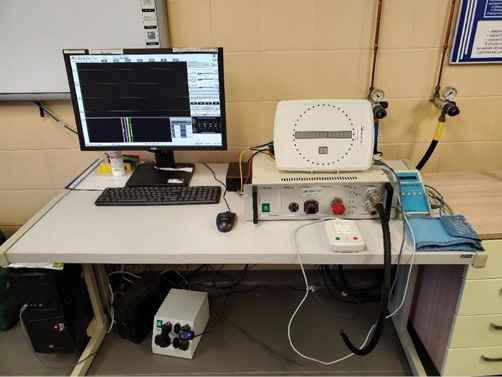
Photo taken by the authors
Fig. 1. Appearance of the BARS-GD equipment set
The developed course of breathing and speech training under OOP includes five OOP breathing sessions, which are conducted once a day for five consecutive days. The sessions were held in the morning, 1.5–2 h after a meal. On the day of the session, the test subjects were exempted from significant physical and psychological stress.
Each session consisted of breathing under OOP sequentially and continuously at five stages with the creation of overpressure at levels of 150–1000 mm H2O; the breathing time at each stage was 2 min. BARS-GD was used in the mode of smooth increase of OOP in the airways. When conducting the session, VKK-15 was necessary due its mandatory use when creating an OOP of more than 300 mm H2O in the human respiratory system.
To assess the impact of the five-day training course on the psychological and psychophysiological indicators of the test subjects, the breathing conditions of a rapid cockpit decompression at an altitude of 14–15 km were simulated using the BARS-GD in the mode of rapid creation of an OOP of 500 mm of water pressure in the respiratory tract.
Prior to and following OOP simulation, the psychological characteristics were assessed using the Spielberger–Khanin anxiety scale and the psychological state assessment method2.
To assess the functioning of the central nervous system (CNS), the average time of a simple visual-motor reaction (SVMR) was evaluated, which characterizes the excitability and lability of the CNS, the mobility of nervous processes, and the balance of excitation and inhibition processes, by performing the tests of complex visual-motor reaction and response to a moving object (SVMR and RMO) [17]. These tests were performed by the test subjects during each training session, as well as during the simulation of rapid decompression.
The training sessions and rapid decompression simulations were performed in strict accordance with the indications, contraindications, and safety measures according to the approved methodology [11][18].
The training effectiveness was evaluated in several ways. First, the participants’ ability to perform respiratory movements under excessive pressure was assessed, since the biomechanics of this process involve significant physical effort to overcome the counterpressure during exhalation, leading to muscle fatigue in the chest and diaphragm within a few minutes. Secondly, the participants’ ability to pronounce control words under these conditions was evaluated, since the ability to maintain radio communication is a key indicator of the professional reliability of pilots. Thirdly, the participants’ psychophysiological reserves under the conditions of OOP were assessed based on the severity of physiological reactions, the level of situational anxiety, well-being, activity, and mood (WAM).
Mathematical and statistical analysis was carried out using the Microsoft® Excel-2016 software, SPSS 26 application package, with calculation of Student’s t-test and Wilcoxon test. The values are presented in the form of median value and quartile spread. The dynamics of indicators without load and after load was compared separately in pre-training and post-training periods. The dynamics of indicators between the periods before and after the training course was also compared. All differences were considered statistically significant at a p-value of < 0.05.
RESULTS
The conducted assessment of personal anxiety found that 23 (66%) and 12 (34%) of the participants demonstrated a high and average level of anxiety, respectively. No participants showed a low level of anxiety.
Significant changes in situational anxiety (SA) were recorded during the examination of the participants before and after the training course. In the absence of OOP load, the SA level decreased by 4% from 43.3 ± 0.9 to 41.6 ± 1.0 points (p = 0.039) after the training course. No statistically significant changes were observed in these indicators before and after the training course. This may indicate that, over the five-day training course, the participants have developed the required level of psychological readiness for the subsequent exposure to an extreme factor (Fig. 2).
A study of the dynamics of SA levels during the simulation of a rapid decrease in pressure in an aircraft pressurized cabin showed a downward trend before and after the training course; however, the data were not statistically significant.
An analysis of the dynamics of the participants’ psychological state using the WAM questionnaire before the training course showed a statistically significant decrease in the well-being indicator by 3.7% (p = 0.003) (Fig. 3) and the mood indicator by 5.7% (p = 0.035) (Fig. 4), indicating that the participants were not prepared for new biomechanical patterns of breathing in the OOP conditions, as well as the occurrence of a number of uncomfortable sensations when using high-altitude and protective equipment. No statistically significant changes were observed when comparing these indicators before and after the training course.
Following the five-day training course, the pilots’ levels of well-being and mood were similar to their pre-training levels. These results reflect the pilots’ subjective assessment of their psychological state, which was characterized by their readiness to withstand extreme conditions, their adaptation to the biomechanics of breathing in the OOP environment, and their use of high-altitude and protective equipment.
The study of the functional state of the CNS before the training course found that the average SVMR time of the participants increased significantly by 39.7% (p < 0.001) after the OOP load compared to the pre-load values; thus, after the training course, the SVMR time increased by 14.1% (p < 0.001). A comparison of the indicators before and after the training course did not show any significant changes. The obtained results reflect less significant changes in the level of CNS functioning after the training course than before the course, which is characterized by a less significant decrease in the speed of neural processes and, consequently, greater psychophysiological reserves (Fig. 5).
The dynamics of the mean CVMR time is presented in Fig. 6. Before the training course, the average CVMR time increased significantly, by 6.6% (p = 0.001), under the OOP load, while the number of erroneous responses remained at the same level. When comparing the CVMR time before and after the psychophysiological training course, the participants showed a decrease in the CVMR time (Fig. 6). At the same time, after the training course, there were no statistically significant changes in the time of the CVMR and the number of erroneous reactions compared to the pre-training values. These data indicate an increase in the psychophysiological reserves of the participants after the training course.
It is also noteworthy that there was a statistically significant decrease in the number of erroneous responses after the five-day training course, which was 65% (p < 0.001) in the absence of stress and 55% (p < 0.001) after exposure to OOP. These results indicate an increase in the CNS functioning under OOP conditions during training and an increase in the psychophysiological reserves of the participants.
The RMO time dynamics, which characterizes the balance of excitation and inhibition of CNS processes during the simulation of cockpit decompression, is presented in Fig. 7. Before the training course, the RMO time changed significantly, by 26.7% (p = 0.001), in the negative range of values from –58 to –73.5 ms. After the training course, the dynamics of this parameter did not have statistical significance, similar to the case when comparing the indicators before and after the training course. From a physiological standpoint, these results are consistent with the changes in the SVMR and CVMR, characterizing the overall dynamics of a decrease in the CNS functioning level under the influence of an extreme flight factor, with the predominance of CNS excitation processes.
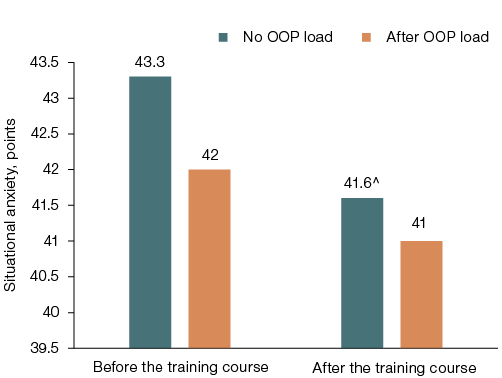
Figure prepared by the authors using their own data
Fig. 2. Situational anxiety changes during rapid creation of an oxygen overpressure (OOP) of 500 mmHg before and after exercise
Note: ^ — the level of statistical significance when comparing the unloaded indicator before and after the training course.

Figure prepared by the authors using their own data
Fig. 3. Well-being changes when oxygen overpressure (OOP) is rapidly increased to 500 mmHg before and after exercise
Note: * — the level of statistical significance (p = 0.003) when comparing the values before and after the training course.
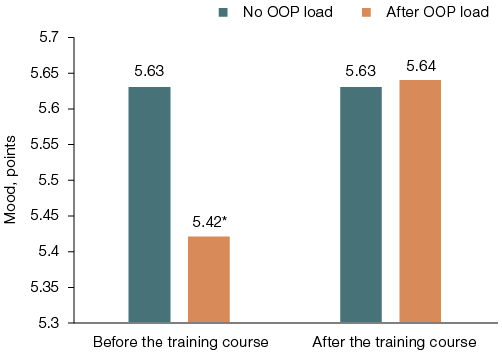
Figure prepared by the authors using their own data
Fig. 4. Changes in mood when oxygen overpressure (OOP) is rapidly increased to 500 mmHg before and after exercise
Note: * — the level of statistical significance (p = 0.035) when comparing the values before and after the training course.
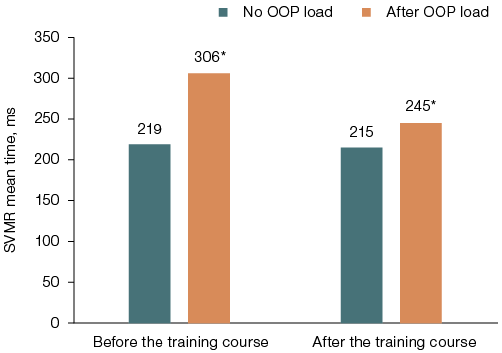
Figure prepared by the authors using their own data
Fig. 5. Dynamics of the mean time of simple visual-motor reaction (SVMR) during rapid creation of an oxygen overpressure (OOP) of 500 mmHg before and after training
Note: * — the level of statistical significance (p < 0.001) when comparing the values before and after exercise in the periods before and after the training course.
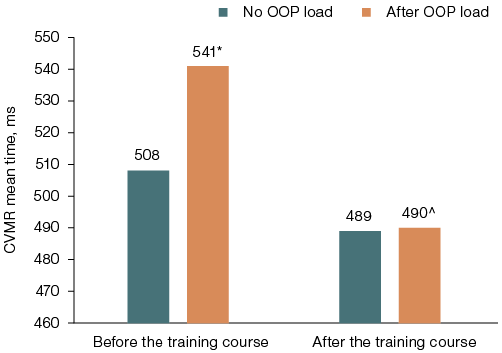
Figure prepared by the authors using their own data
Fig. 6. Dynamics of the mean time of complex visual-motor reaction (CVMR) during rapid creation of oxygen overpressure (OOP) at a level of 500 mm H2O before and after training
Note: * — level of statistical significance (p = 0.001) when comparing indicators without and after exercise before the training course; ^ — level of statistical significance (p = 0.001) when comparing indicators after exercise before and after the training course.
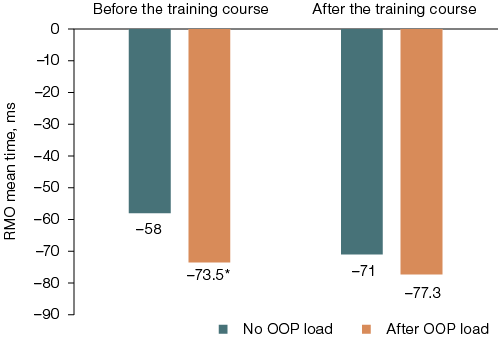
Figure prepared by the authors using their own data
Fig. 7. Mean time dynamics of response to a moving object (RMO) during rapid creation of an oxygen overpressure (OOP) of 500 mmHg before and after training
Note: * — the level of statistical significance (p = 0.001) when comparing the values before and after the training course.
DISCUSSION
The conducted series of experiments have confirmed a significant effect of breathing under OOP on the psychological state and CNS functioning in test subjects who had no previous experience of such programs. However, after undergoing psychophysiological training and developing psychological and physiological readiness for exposure to OOP, statistically significant changes in psychophysiological indicators were recorded.
The five-day course of breathing and speech training under OOP among Vietnamese pilots improved their psychological readiness for exposure to extreme flight factors [2], which is evidenced by a statistically significant decrease in the participants’ background situational anxiety and the absence of statistically significant changes in their well-being and mood after the training course. These are representative subjective indicators of psychological state. Given the non-physiological biomechanics of breathing under OOP conditions, which is characterized primarily by active exhalation, the pilot’s psychological state plays a significant role in the success of their training [9]. In the context of stratospheric flights and sudden cockpit decompression, a pilot’s lack of psychological readiness can pose a significant threat not only to the completion of the entire mission but also to the lives of the crew members and the safety of the aircraft [4].
Statistically significant changes in the psychophysiological indicators of the test subjects reflect the physiological aspect of their adaptation to breathing under OOP conditions and the use of high-altitude and protective equipment. The increase in psychophysiological reserves during the five-day training course indicates the formation of the corresponding breathing skills [13]. This mitigates the uncomfortable and limiting effects of high-altitude equipment, such as pressure on the face and neck, discomfort in the oral cavity, allowing pilots to conduct high-quality and clear radio communication.
CONCLUSION
The conducted research is part of a larger scientific project aimed at improving the safety and efficiency of piloting Russian-made jets in Southeast Asian countries. Modern aviation equipment places high demands on flight personnel during maneuvers and stratospheric missions. One of the challenges in medical support and training for Vietnamese flight personnel consists in the lack of an effective program for stratospheric flights, which can be conducted using Russian high-altitude and protective equipment.
This study showed the effectiveness of the developed five-day training course in maintaining the professional performance of Vietnamese test pilots under the conditions of a rapid depressurization of the aircraft cabin and breathing under OOP. The course effectiveness was confirmed, on the one hand, by the development of skills for performing an active exhalation with additional effort and for maintaining voice communication with the flight director and crew members, and, on the other hand, by statistically significant changes in psychological and psychophysiological indicators that demonstrate improved psychological readiness among test pilots and an increase in their psychophysiological reserves.
The conducted research provides grounds for recommending the breathing and speech training mode under OOP for inclusion in the medical support system for flights by Vietnamese pilots, particularly in terms of training for stratospheric and maneuverable flights on Russian-made jets.
1 Gradwell DP. Human physiological responses to positive pressure breathing for high altitude protection. PhD thesis. London: University of London; 1993.
2 Mantrova IN. Methodological guide to psychophysiological and psychological diagnostics. Ivanovo; 2005 (In Russ.).
References
1. Nikiforov DA. The current state of the concept of reliability of a human operator of ergatic systems. Life Safety. 2024;4(280):13–21 (In Russ.).
2. Zhdanko IM, Isaenkov VE, Vorona AA, Filatov VN, Nikiforov DA. Professional reliability of military pilots: medical and social-psychological aspects. Military Medical Journal. 2016;337(6):30–6 (In Russ.). EDN: WLBOWT
3. Kholikov IV, Vovkodav VS. Human factor of flight safety: military-legal aspects. Military Law. 2017;6(46):177–9 (In Russ.). EDN: ZTHTJZ
4. Razinkin SM, Dvornikov MV. Physiology and hygiene of a pilot in extreme conditions. Moscow: Scientific book; 2019 (In Russ.). EDN: YFMFRF
5. Filatov VN, Shishov AA, Dvornikov MV, Shishkin AN, Ryzhov DI, Nikiforov DA. Hypobaric chamber ascents as a method of psychophysiological training for risky occupations associated with exposure to high-level hypoxia. Aerospace and Environmental Medicine. 2022;56(2):64–72 (In Russ.). https://doi.org/10.21687/0233-528X-2022-56-2-64-72
6. Rybnikova EA. Current trends in modern research on hypoxia problems. Collection of abstracts of the XXIV Congress of the Pavlov Physiological Society. St. Petersburg; 2023:416 (In Russ.). EDN: EYXJTV
7. Vu QH, Annenkov OA. The influence of breathing and speech training under oxygen overpressure on the dynamics of physiological parameters during modeling of aircraft cabin depressurization. Aviation medicine: past, present, future. Collection of abstracts of the XI All-Russian scientific and practical conference with international participation dedicated to the 85th anniversary of the Department of Aviation and Space Medicine of the Federal State Budgetary Educational Institution of Higher Professional Education RMANPO. Moscow; 2024:84–6 (In Russ.). EDN: CKYIVL
8. Shishov AA, Olenev NI, Shishkin AN. Development of a technique for altitude chamber elevations for medical flight examination and psychophysiological preparation of flight personnel for high-altitude flights in a hospital. Current issues of aerospace medicine, aviation psychology and military ergonomics. Collection of scientific papers based on the results of the scientific-practical conference dedicated to the 85th anniversary of the Research Center (AKM and VE). Moscow; 2020:290–302 (In Russ.). EDN: GTBNYR
9. Lindelis AE, Fraser WD, Fowler B. Performance during positive pressure breathing after rapid decompression up to 72 000 feet. Human Factors. 1997;39:102–10. https://doi.org/10.1518/001872097778940641
10. Ryles MT, Perez–Becerra JL. The effect of positive pressure breathing for altitude protection on intraocular pressure. Aviation, Space, and Environmental Medicine. 1996;67:1179–84.
11. Dvornikov MV, Medenkov AA, Stepanov VK. Selection and adjustment of protective equipment. Training in breathing under excess pressure. Moscow: Polyot; 2001 (In Russ.).
12. Shishov AA, Bogomolov AV. Physiological substantiation of adequate emergency escape in high-altitude flight. Aerospace and Environmental Medicine. 2020;54(2):65–71 (In Russ.). https://doi.org/10.21687/0233-528X-2020-54-2-65-71
13. Dvornikov MV, Medenkov AA, Nesterovich TB. Psychophysiological resources and reserves for increasing flight safety. Military Medical Journal. 2017;338(3):51–8 (In Russ.). EDN: YKQPPJ
14. Klyuchanskaya SA. Prospects for cooperation between Russia and the countries of Southeast Asia in strategic areas. Security Index. 2011;17(2):55–85 (In Russ.). EDN: OWHLRD
15. Chernyakov IN, Shishov AA. Maintenance of vitality and performance in pilots by means of oxygen complex in emergency depressurization of the cabin. Russian Journal of Occupational Health and Industrial Ecology. 1995;3:25–8. EDN: KTBYDH
16. Korzunin VA, Yusupov VV. Neuropsychic stability and its assessment in military personnel. News of the Russian Military Medical Academy. 2020;39(3–4):131–5 (In Russ.). EDN: TDFCHB
17. Shutova SV, Muravyova IV. Sensorimotor reactions as a characteristic of the functional state. Bulletin of Tambov State University. 2013;18(5–3):2831–40 (In Russ.). EDN: RFEEMH
18. Medenkov AA. Taking into account the pilot’s capabilities and abilities in the flight safety system. Flight Safety Problems. 2021;8:3–26 (In Russ.). https://doi.org/10.36535/0235-5000-2021-08-1
19.
About the Authors
A. А. BlagininRussian Federation
Andrey А. Blaginin, Dr. Sci. (Med.), Dr. Sci. (Psych.),
Professor
St. Petersburg
Q. H. Vu
Russian Federation
Quang H. Vu
St. Petersburg
O. A. Annenkov
Russian Federation
Oleg A. Annenkov, Cand. Sci. (Med.)
St. Petersburg
Supplementary files
Review
For citations:
Blaginin A.А., Vu Q.H., Annenkov O.A. Psychophysiological training of pilots for cases of emergency cockpit decompression. Extreme Medicine. 2025;27(3):367-374. https://doi.org/10.47183/mes.2025-271

















